Nexus 5X Review: An Outstanding Value
The midrange Nexus 5X starts at less than $400 unlocked, and features a great camera and epic battery life.
Why you can trust Tom's Guide
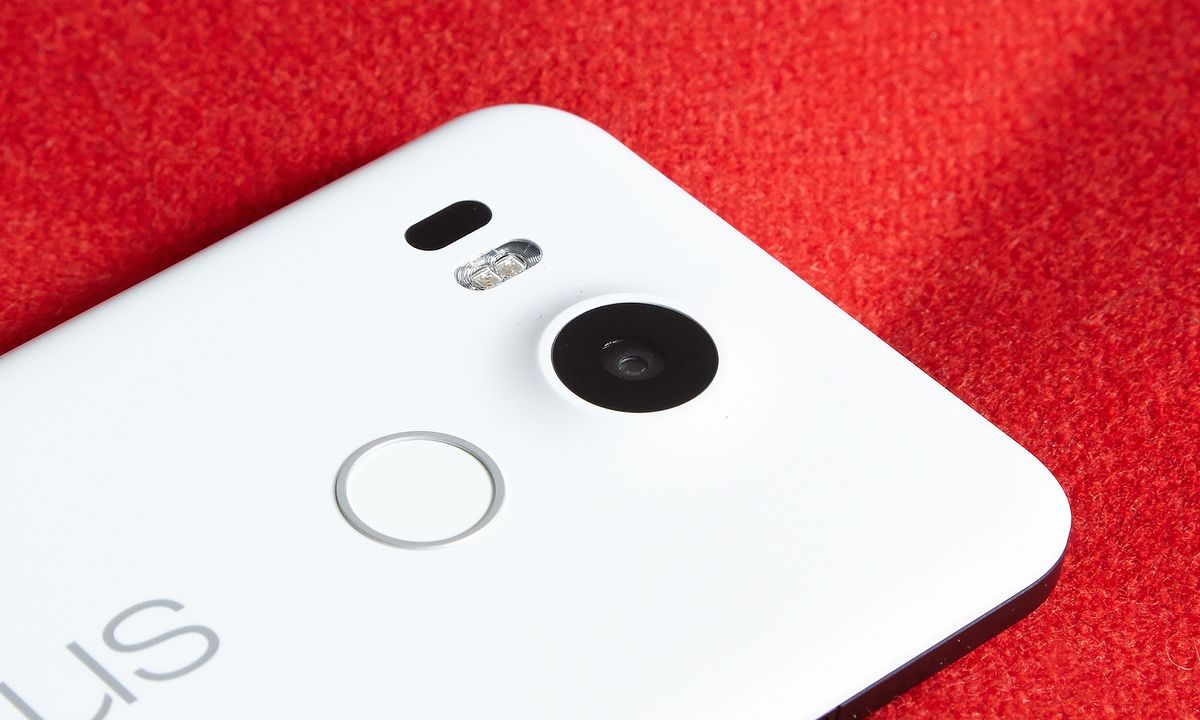
Getting excited about a midrange phone like the Nexus 5X might seem like trying to get psyched for a Toyota Prius. It's not attractive and doesn't pack as many features as a Tesla, nor is it as inexpensive as, say, a Ford Focus. But what the Nexus 5X ($379 unlocked) offers is strong performance, a great camera and superb battery life. That adds up to a very good phone for the price.
Design
Unlike the larger and higher-end Nexus 6P, which has an all-metal design, the Nexus 5X has a plastic back that comes in white, black or what Google calls "Ice," which is a pale turquoise. Overall, this phone has a very clean aesthetic, with straight, smooth lines. With its gently rounded corners, the 5X feels almost like a Lumia phone.
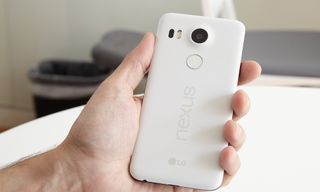
At the top of the back is a camera, which bulges out slightly, as well as a flash. Just below the camera is a small circle ringed in silver that's the same size as the lens; this is the 5X's fingerprint sensor. Below that, you'll find Nexus branding and LG's logo, which is the company that made the phone for Google.










The bottom of the Nexus 5X has a USB Type-C connector and a 3.5mm headphone jack, while the left side has a micro SIM card slot. The $379 model of the Nexus 5X comes with 16GB of onboard storage; upgrading to 32GB increases the price to $429. Unfortunately, there's no microSD card slot.

At 5.8 x 2.9 x 0.31 inches and 4.8 ounces, the 5X is lighter but thicker than the iPhone 6s (5.04 ounces and 0.28 inches), but heavier than the Samsung Galaxy S6 (4.6 ounces). The Alcatel Idol 3 is about the same weight as the Nexus, at 4.85 ounces.
Carrier Support and Project Fi
In a fairly novel feature for unlocked phones, the Nexus 5X has multiband support, meaning it can ride on both GSM and CDMA networks. The 5X is also compatible with Google's new Project Fi service. Riding on T-Mobile and Sprint's networks, Google's Mobile Virtual Network Operator (MVNO) switches between the two, and offers very competitive rates.
MORE: Best Cheap Unlocked Smartphones
For $20 per month on Project Fi, Google offers Wi-Fi tethering, unlimited talk and text, and international texting. Data is at $10 per gigabyte, so a plan with 3GB of data will cost you $50 per month.
While you're billed at the start of the month, Google will credit your account if there's any data left over at the end of the period. So, if you paid for 4GB of data ($40) but used only 2GB, Google will credit the remainder ($20) back to your bill.
Display
The 5X's 5.2-inch, 1920 x 1080p LCD display is modest by today's ultra-HD standards, but personally, I'll trade pixels if it means more battery life. Blacks and contrast weren't as deep or as strong as on other phones, so the darker scenes in trailers for Batman v. Superman and Suicide Squad looked somewhat washed out. The green hair of Jared Leto's Joker wasn't quite as iridescent as I've seen on other phones, such as the Samsung S6.
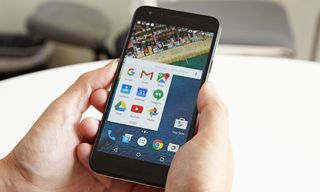
Shining at 453.6 nits, the Nexus 5X was brighter than the average smartphone (428 nits) and the iPhone (452 nits), but just barely. The Moto X (479), Samsung S6 (521) and Idol 3 (736) were all brighter.
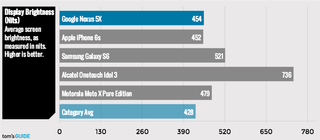
The 5X was able to reproduce 106.3 percent of the sRGB color gamut. That's higher than the Idol 3 (94 percent) and on a par with the iPhone (108.6) and Moto X (106), but lower than the average (123) and the S6's score of 159. Generally, however, being higher than 100 percent isn't necessarily better; you're just getting a more saturated screen.
One number that is important is the color accuracy, or Delta-E score. Here, the Nexus' 0.61 score — numbers closer to zero are better — outdid all but the iPhone's superaccurate score of 0.34.
While the Nexus 5X has matching grilles above and below its display, don't be fooled into thinking this is the next HTC One. Only the bottom grille acts as a speaker, producing good but not great sound. When I watched the aforementioned trailers, everything sounded a bit tinny.
Fingerprint Sensor
Like the Nexus 6P, the 5X has a large, round fingerprint sensor on its back. I was initially skeptical of the sensor's placement on the back of the 5X, but it quickly won me over. Since I didn't have to swipe my finger, I found that my index finger naturally moved to the sensor when I picked up the phone.

I found this sensor just as easy to set up and use as the fingerprint sensor on the iPhone 6. To register your finger, you merely tap your digit on the pad a few times to make sure all the angles are covered.
I found that my index finger naturally moved to the back fingerprint sensor when I picked up the phone.
In addition to unlocking the phone, you can also use the fingerprint sensor to approve purchases in Google Play, as well as when using Tap to Pay.
Android Marshmallow
The 5X is one of the first phones to run version 6.0 of the Android operating system, otherwise known as Marshmallow. It continues the flat design of its predecessor, but makes a lot of improvements under the hood.
For one, Marshmallow now supports the fingerprint reader and USB Type-C connector found on the 5X and the 6P.
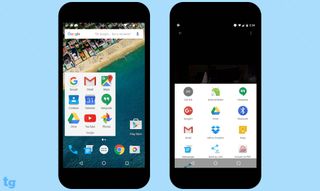
Direct Share offers a multitude of choices to share content with others, based on the apps you have installed. For example, in the Photos app, clicking the Share button brought up more than a dozen options, including Facebook, Android Beam, Hangouts, Drive, Gmail, Dropbox and Bluetooth.
Voice Commands
In a crowded restaurant with no TVs, the 5X was able to hear me say, "How are the Mets doing?" but Google Now brought up their position in the standings, not the score of the first game of the National League Championship Series. Still, the phone remembered my query, and from then on, a little baseball would appear in the upper left corner of the screen if there was a scoring update.

The next day, I asked Google, "How are the Jets doing," and it returned a card showing the football team's standings in the division (perhaps because I was in New York, and not Winnipeg, it correctly assumed I meant the football, and not the hockey team). However, I was able to follow it up with "What's the score of the game?" and Google Now correctly assumed I meant the Jets, and showed me that they were trouncing Washington.
Marshmallow will expand voice support to third-party apps, but aside from TuneIn, which was specifically referred to by Google, no other apps can currently use this feature.
MORE: Smartphones with the Longest Battery Life
Google Now on Tap (NOT) is Marshmallow's newest trick, offering contextual searches based on what you're reading. For example, as I was reading an article on the Monday Night Football game between the Philadelphia Eagles and the New York Giants, I pressed and held the home button for 2 seconds. The 5X then brought up cards for the game, both teams, their respective head coaches and, oddly, the classic-rock band the Eagles.
Performance
The Nexus 5X isn't going to blow you away with its raw power, but its 1.8-GHz hexa-core Qualcomm Snapdragon 808 processor and 2GB of RAM proved fairly snappy in everyday tasks. Opening the camera was a little slow, at just under 2 seconds, but returning to the home screen took less than half a second. Launching Facebook took 2.85 seconds, but my virtual Lamborghini smoothly cruised the streets of Extreme Car Driving.
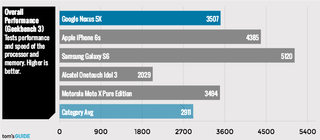
On Geekbench, the 5X's score of 3,507 was better than the average smartphone (2,829) and the Idol 3 (2,029), but scored below the iPhone 6s (4,385) and the Samsung Galaxy S6 (5,283).
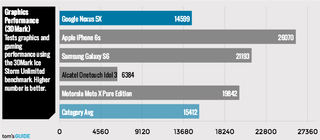
The Nexus 5X's graphics performance on 3DMark Ice Storm Unlimited (14,599) fell below the average of 14,806, but not by much. It also fared worse than the Moto X (19842), iPhone (26,070) and Samsung (21,193). Only the Idol 3 (6,384) did worse.
A photo I took of an arugula pizza in a dark restaurant looked good enough to eat.
Camera
I was generally impressed with the rear, 12.3-MP camera on the 5X, which is the same as used on the Nexus 6P. A photo I took of an arugula pizza in a dark restaurant looked true to life. The greens on top were bright green, the tomato sauce a deep red, and the char on the crust looked good enough to eat.

The 1.55um sensor, capable of shooting at f/2.0, produced images that had little grain, even in dim settings. The black areas around a set of red lamps were largely devoid of artifacts.

In better-lit settings, the camera produced some tack-sharp images. You can see every whisker in a photo of a cat basking in the sun, and the 5X's HDR mode did a good job of managing both the darker and lighter areas. However, it took the 5X a second to shoot and process photos in HDR mode, which made it difficult to photograph moving subjects.

The only other issue I encountered was when I took a photo of a lamp-lit street. When one of the streetlights was at an oblique angle to the camera, there was too much lens flare throughout the photo.

The front, 5-MP camera was just as capable, picking up not only the details on my shirt clearly, but also accurately rendering its deep blue color.

Battery Life
Packing a 2,700-mAh battery, the Nexus 5X lasted an excellent 11 hours and 30 minutes on our battery test (Web surfing via LTE with the screen at 150 nits). The 5X we received came unlocked, but we installed a Verizon SIM for this test. That blew past the 7:54 average, the Idol 3 (9:16), the iPhone (6:46) and the Samsung (8:32).

The Nexus 5X also supports fast charging; according to Google, just 10 minutes plugged in will provide up to 4 hours of battery life. After draining the phone completely, it was up to 97 percent within an hour.
Nexus 5x vs. Nexus 6P
The Nexus 5X isn't the only new Google phone on the block. The Nexus 6P, which starts at $499, has a metal frame; a larger, 5.7-inch, 2560 x 1440 AMOLED display; faster 2-GHz octa-core Qualcomm Snapdragon 810 processor with 3GB of RAM; and a larger 3,450 mAh battery that lasted 12.5 hours. The 6P has the same 12.3-MP rear camera as the 5X, but where the latter has a 5-MP front camera, the 6P has a 6-MP front shooter.
Bottom Line
The Nexus 5X lacks gee-whiz features such as a curved display or 3D touch, but does any of that matter when you've got an above-average camera and great battery life in an affordable package? Starting at $379 unlocked, the 5X costs nearly $300 less than the iPhone 6S and Nexus S6.
Among unlocked smartphones under $400, the Alcatel OneTouch Idol 3 costs just $249 and has expandable storage, but it also has shorter battery life, worse performance and a poorer camera. Those who want an even-more-premium experience should check out the $499 Nexus 6P, but when it comes to affordable unlocked smartphones, it's hard to find a better deal than the 5X.
Sign up to get the BEST of Tom's Guide direct to your inbox.
Get instant access to breaking news, the hottest reviews, great deals and helpful tips.

Michael A. Prospero is the U.S. Editor-in-Chief for Tom’s Guide. He oversees all evergreen content and oversees the Homes, Smart Home, and Fitness/Wearables categories for the site. In his spare time, he also tests out the latest drones, electric scooters, and smart home gadgets, such as video doorbells. Before his tenure at Tom's Guide, he was the Reviews Editor for Laptop Magazine, a reporter at Fast Company, the Times of Trenton, and, many eons back, an intern at George magazine. He received his undergraduate degree from Boston College, where he worked on the campus newspaper The Heights, and then attended the Columbia University school of Journalism. When he’s not testing out the latest running watch, electric scooter, or skiing or training for a marathon, he’s probably using the latest sous vide machine, smoker, or pizza oven, to the delight — or chagrin — of his family.
Most Popular

